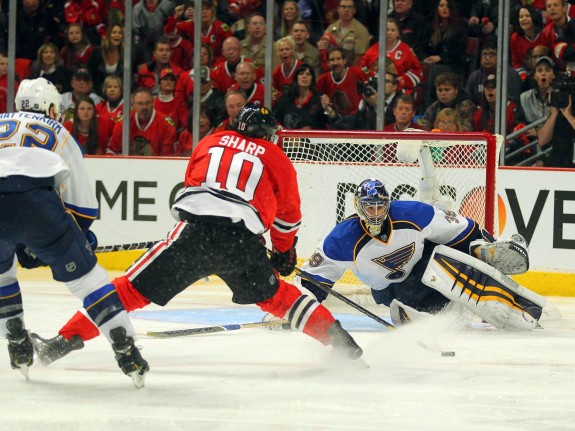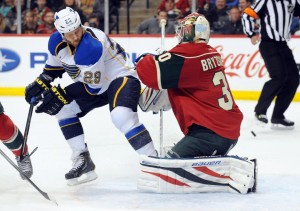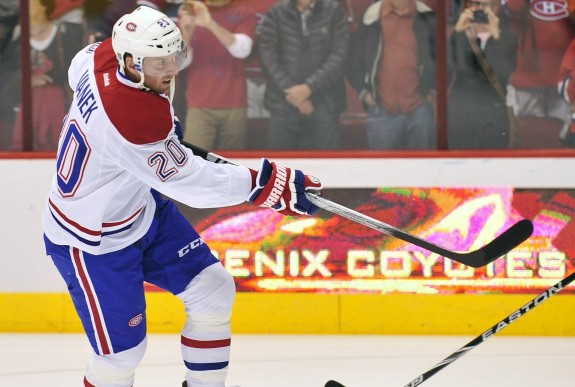A few new faces, another big trade and the same result.
Blues fans watched their favorite team implode on the ice Sunday afternoon when they allowed four third period goals to the Chicago Blackhawks. After owning a two-games-to-none series lead, the Blues dropped the next four games to be sent home early in the playoffs yet again — something that Blues fans have trouble getting used to. The St. Louis hockey team last made the Western Conference finals in 2001 and has only seen the second round three times since the 1999-2000 season.

The last two seasons, Blues management has attempted to bring in that final piece at the trade deadline to change the course of history. Last season, it was acquiring Jay Bouwmeester from the Calgary Flames in exchange for prospects and picks.
This season, the big move was for a goaltender. General manager Doug Armstrong moved starting goalie Jaroslav Halak, right-winger Chris Stewart, prospect William Carrier, a 2015 first-round pick and a conditional 2016 third-round pick to the Buffalo Sabres in exchange for netminder Ryan Miller and forward Steve Ott. This was Armstrong’s big move to thrust his team to the Promised Land.
[See related: It’s Do or Die for Ryan Miller in St. Louis]
At the time of the trade, Ott and Miller, both free-agents in July, were considered to be on the border of long-term and short-term additions. It was unclear whether the two former Sabres would return to the Bluenote in 2014-15.
Just two short months later, the answer seems more obvious than ever.

Ott, 31, played in 29 total games for the Blues (regular season and playoffs), registering just five assists and posting a dismal minus-15. Despite averaging 19:04 of ice time in the playoffs (sixth-most among Blues forwards), the rugged winger was mostly ineffective during his short tenure. His time with the Blues will likely mirror that of 1991 trade deadline acquisition Dan Quinn.
Miller, the marquee name in the trade, posted a forgettable 2.70 GAA to go along with a sub-par .897 save percentage in the playoffs — undoubtedly unattractive numbers for a goalie known to shine in clutch situations.
However, Miller was not the Blues’ biggest problem. The team lacked any offensive creativity and looked lost at times in their own zone. Pick any Blackhawks goal in the series and you will find Exhibit A. Let’s not even mention that horrendous 2-for-29 power-play squad.
There are other reasons that this trade will forever be a black mark on the organization’s transaction registry.
Received same result from backup
Last postseason, with Halak sitting on the bench, Brian Elliott became the Blues’ No. 1 netminder. Although he lost to the Los Angeles Kings in six games, Elliott recorded some impressive numbers that are noticeably better than Miller’s.

As you can see, Miller did receive more time (triple-overtime games will do that), but his stats are appalling for someone expected to be the sure-fire No. 1 goaltender on a team with Stanley Cup aspirations. It seems, though, that Elliott could have provided the Blues with just as much assurance in the net.
Management made the wrong move
As stated before, Miller was not exactly the team’s problem. The glaring weakness was the team’s abysmal offensive-zone play, which resulted in turnovers and laughable shots taken on Corey Crawford.
This team still lacks a proven goal scorer who rises above the rest and adds the big goal(s) when the roster absolutely needs it (wow, do I sound like a broken record?)
A better move could have been right under their noses.
Some names were taken at the trade deadline that could have added an offensive punch to the Blues’ lineup. Thomas Vanek, sent from the New York Islanders to the Montreal Canadiens, provided his team a hat trick on March 18 against the well-oiled Colorado Avalanche and also added a third period, go-ahead goal in Game 1 against the Tampa Bay Lightning (Steven Stamkos tied the game later but Dale Weiss won it for Montreal in overtime). The Canadiens didn’t need him to score again as they swept the Lightning, but having him in the lineup only improves their chances of victory.
Factor in what the Canadiens gave up for him — prospect Sebastien Collberg and a 2014 second-round draft pick — and you see that the asking price for a two-time 40-goal scorer was much less than what was asked for the highly touted goaltender.

Future provides no hope

That star forward may well be on the team’s roster right now. Vladimir Tarasenko tallied four goals in the six games, proving that he may be the go-to guy for future playoff runs.
Unfortunately, the rest of the Blues offense provided nothing behind him. Given where the Blues will draft the next few seasons, it may be a trend that the city of St. Louis will have to get used to.
The Miller trade sets the Blues back from a first-round pick in 2015 (which is widely known as a deep draft), and could also relieve the Blues of a first-round pick in 2014 if the team re-signs or trades Miller before the draft.
The 2013 draft was sacrificed, as well. The acquisitions of Bouwmeester and Jordan Leopold allowed the Blues to make just four draft selections. Two were picked in the second round (Tommy Vannelli, Carrier), one in the fourth round (Zach Pochiro) and another in the sixth round (Santeri Saari). Take Carrier out of the equation and the Blues made less than half the available picks to a team in the NHL Draft (7).
Unless you’re the Detroit Red Wings, your true goal scorers come from the first round of the draft. Of the top 10 NHL point scorers this season, eight were taken from their respective first-round class. In addition, there has been just one player not taken in the first round to win the Art Ross Trophy since the 1979-80 season (Martin St. Louis).
It’s true, folks, scoring dynamos like Brett Hull don’t just show up and ring your doorbell every day. However, Doug Armstrong has uninstalled his bell and barricaded the front door to prevent such occurrences from taking place.
Calling it the most unnecessary trade in Blues history sounds more realistic.
What Armstrong once called a “5 or 6 percent upgrade” has likely set the Blues back for the foreseeable future.
Comments are closed.